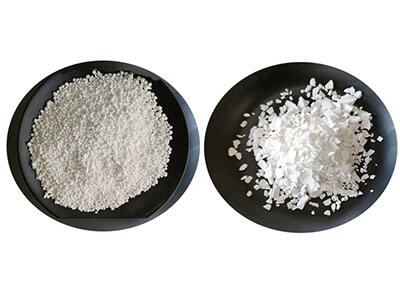Najnowsze trendy w zastosowaniach chlorku wapnia: formy bezwodne kontra dwuwodne
Chlorowodór wapnia to związek chemiczny o szerokim zakresie zastosowań, powszechnie znany z licznych zastosowań w różnych branżach dzięki swoim różnorodnym właściwościom. Dwie główne odmiany tego związku – bezwodna i dwuwodna – charakteryzują się wyraźnie różnymi cechami, które czynią je odpowiednimi do konkretnych zastosowań. Wobec rosnącego zapotrzebowania na efektywne i skuteczne rozwiązania, branże analizują możliwości wykorzystania tych formularzy szczególnie jako środek suszący, do odśnieżania oraz w przetwórstwie żywności. Niniejszy artykuł omawia higroskopijność bezwodnego chlorku wapnia oraz korzyści płynące ze stabilności chlorku wapnia dwuwodnego w różnych zastosowaniach przemysłowych.
Właściwości higroskopijne bezwodnego chlorku wapnia w zastosowaniach jako środek odwilżający i przeciwgołoledowy
Chlorek wapnia bezwodny jest znany z tego, że jest higroskopijny, czyli łatwo wchłania wilgoć z otoczenia. Produkt ten odgrywa kluczową rolę jako środek suszący i do odśnieżania.
Chlorek wapnia bezwodny jest najskuteczniejszy jako środek suszący. Stanowi bardzo cenny składnik produktów kontrolujących wilgotność dzięki swoim właściwościom przyciągania i zatrzymywania wody. Chlorek wapnia bezwodny stosuje się również w zastosowaniach przemysłowych, gdzie wilgotność stanowi poważne zagrożenie, na przykład podczas pakowania elektroniki czy produktów farmaceutycznych, aby utrzymać produkt suchy i nienaruszony. Jego duża rozpuszczalność w wodzie oznacza, że potrafi wiązać wilgoć nawet przy niskiej wilgotności względnej, wydłużając tym samym trwałość produktów oraz zachowując integralność wrażliwych materiałów. Można go również wykorzystywać w produktach użytku domowego, gdzie służy utrzymaniu suchego środowiska, zapobiegając rozwojowi pleśni i grzybów.
Szczególne znaczenie w procesie odśnieżania mają higroskopijne i egzotermiczne właściwości chlorku wapnia bezwodnego. Gdy wchodzi on w kontakt z lodem, szybko pochłania wilgoć, rozpuszcza się i niszczy strukturę lodu. Reakcja egzotermiczna wydziela ciepło, co dodatkowo przyspiesza proces topnienia. To działanie podwójne sprawia, że bezwodny chlorek wapnia jest szczególnie ceniony w ekstremalnych warunkach zimowych. Ponadto nadaje się do użytku przy niższych temperaturach niż inne sole, co oznacza, że sieci transportowe mogą być użytkowane nawet w trudnych warunkach pogodowych, co zmniejsza straty ekonomiczne i zapewnia większe bezpieczeństwo.
Zalety stabilności dwuwodnego chlorku wapnia w formulacjach dodatków do przetwórstwa spożywczego
Chlorek wapnia dwuwodny, dzięki stałemu składowi i wygodnej obsłudze, stał się powszechnie stosowany w przemyśle spożywczym. Jako dodatek pokarmowy oferuje wiele korzyści, które poprawiają jakość żywności oraz jej bezpieczeństwo.
Jednym z najważniejszych zastosowań chlorku wapnia dwuwodnego w przetwórstwie spożywczym jest utrzymywanie twardości produktów takich jak owoce i warzywa. Zapobiega miękkieniu konserw i przetworzonych produktów spożywczych, dzięki czemu zachowana zostaje ich konsystencja i wygląd. Stabilność tej formuły gwarantuje stały poziom dostarczania wapnia, co jest kluczowe dla kontroli jakości.
Chlorek wapnia dwuwodny stosuje się w przetwórstwie mleczarskim do normalizacji zawartości wapnia w mleku w celu jego skrzepnięcia podczas produkcji sera. To prowadzi do lepszej jakości oraz wydajności twarogu, co czyni go przydatnym narzędziem dla producentów sera. Jego jednolita przygotowanie umożliwia przebieg wymaganych reakcji chemicznych bez wprowadzania zmienności do procesu.
Dodatkowo przyczynia się do produkcji napojów, szczególnie piwa i cydru. Chlorek wapnia dwuwodny reguluje poziom wapnia i wpływa na twardość wody, co z kolei wpływa na smak i stabilność napoju. Forma dwuwodna jest bardziej stabilna niż bezwodna, dzięki czemu jej użycie nie zależy od zmian wilgotności, zapewniając stałe wyniki we wszystkich partiach.
Podsumowanie
Odkrycie form bezwodnych i dwuwodnych chlorku wapnia stwarza szereg możliwości dla branż poszukujących spersonalizowanych rozwiązań. Zastosowanie chlorku wapnia bezwodnego i jego niesamowite właściwości higroskopijne są kluczowe w procesach osuszania i usuwania lodu, które charakteryzują się wysoką skutecznością i bezpieczeństwem. Z drugiej strony, stabilność chlorku wapnia dwuwodnego ma swoje zalety w przetwórstwie spożywczym, poprawiając jakość i jednolitość produktów.
 EN
EN
 AR
AR BG
BG HR
HR NL
NL FI
FI FR
FR DE
DE IT
IT KO
KO NO
NO PL
PL PT
PT RU
RU ES
ES SV
SV TL
TL ID
ID LV
LV SL
SL UK
UK VI
VI SQ
SQ HU
HU MT
MT TH
TH TR
TR FA
FA MS
MS BE
BE HY
HY AZ
AZ KA
KA BN
BN CEB
CEB






